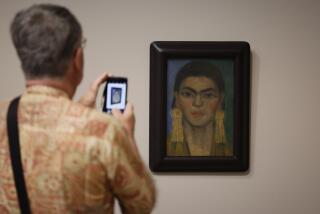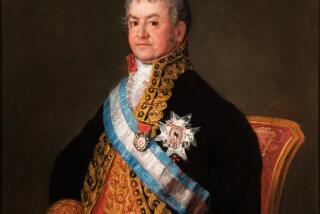Mao Is Their Canvas
- Share via
BEIJING — It happens every year, under cover of darkness, in the waning days of September. The giant portrait of Chairman Mao in Tiananmen Square -- he of the Mona Lisa gaze, flushed cheeks and trademark gray suit -- is spirited away and replaced by a new Mao. He looks just like the old Mao.
So little is known about the making (or rather, remaking) of this iconic image, it might as well have materialized out of thin air.
“This venture was considered by the party to be top secret,” said Wu Hung, an art historian at the University of Chicago. “It is not just a painting. It represents Mao himself. People were supposed to worship this image. They wanted to take the artistic and human elements out. Nobody is allowed to ask who did the image. It just magically appears.”
Who, then, is the phantom Leonardo da Vinci of Tiananmen Square?
At least six painters are known to have freshened up the founding father of Communist China every year for the last 57 years. Most lived in relative obscurity, and three have taken their stories to the graves.
Today, Wang Guodong is 76, in frail health and hard of hearing. He worked on the big painting every summer from 1964 to his retirement in 1976, the year Mao died. That was the only time the brightly colored painting was temporarily replaced by a somber black-and-white photograph more appropriate for the mourning of the great leader.
Wang said he rarely received visitors and didn’t like to talk about the past. Nor did he tend to think of himself as a master who should be credited for the famous portrait.
“Nobody is allowed to put their names on that painting,” Wang said in a phone interview from his home in Beijing. “It’s that way before, and it’s that way now.”
Forsaking fame and glory was easy. But being attacked by fanatical Red Guards during the political chaos of the 1966-76 Cultural Revolution had been hard to swallow. Wang was shipped off to work as a carpenter in a framing factory for two years.
One of his alleged crimes? Painting Mao at a slight tilt from the viewer that showed only one ear. The Red Guards said it implied that the chairman listened to only a select few rather than all of the masses.
“How many ears I painted was not up to me. It was decided by the central government,” said Wang, who despite his infraction kept painting the portrait during his years at the framing factory. He said all of the artists drew Mao from an official black-and-white photograph issued by the state-run New China News Agency. Very little deviation or personal touch was permitted.
The biggest alteration to the official image happened soon after the 1949 revolution that brought Mao to power. The portrait of Mao on display during the ceremony to mark the founding of Communist China showed him in an octagonal army hat and a coarse uniform. It lasted one year. Since then, Mao has appeared basically unchanged to the average eye, except maybe slightly older.
So why the yearly change?
Because the portrait is hung outside and exposed to the elements, it can easily fade and crack. Instead of retiring the old canvas to a museum or storage house, the image is covered with gesso so a new one can be painted on top. When it is removed for repainting, it is replaced by an identical portrait that has been freshened. The two portraits rotate each year.
The repainting takes place each August and September. The switch typically happens a few days before the Oct. 1 national holiday, when China celebrates the birth of the nation.
At nearly three stories high, its size makes it a physical challenge to paint and transport, so for years the painting was done in a temporary tent by the entrance to the Forbidden City behind the gate of Tiananmen.
In the early 1970s, the workplace was upgraded to a secret art studio made entirely of metal, apparently to make it fireproof. Insiders called it the “metal shack.” To this day, it stands in an easy-to-miss corner of the Forbidden City, unmarked and cordoned off to the public like a prison, with no windows or visible doors except for vents near the roof.
At the height of Mao’s power, his face was reproduced and hung in homes, schools and factories across the nation. Demand was so great for public murals of Mao, as well as of other socialist icons such as Marx, Engels, Lenin and Stalin, authorities asked Wang in 1975 to train a group of apprentices.
Wang selected 10 Beijing high school students, most of them art enthusiasts active in campus propaganda brigades. The criterion at the time was not so much artistic talent but political reliability. After all, the job is repetitive, and there is little room for creativity.
“We were told that if you were one of the chosen ones, you won’t be able to paint anything else in your life but the great communist leaders,” said Liu Yang, 49, who was 18 when he joined Wang’s class.
For the next three years, the students learned the basics of portrait painting and how to never veer from the realm of the politically correct.
“Mao’s face must be painted extra red to show his robust spirit,” Liu said. “It can never be too yellow, which would seem sickly, like he hadn’t eaten in days. You could be accused of being a counterrevolutionary.”
At the end of the training sessions, the best student was given the chance to show his work at Tiananmen.
The year was 1979, and Liu saw his canvas displayed for the first and only time before the nation. Few besides his teacher and classmates knew about it.
“Of course I was proud, but I couldn’t brag about it,” said Liu, who has no photograph of the crowning achievement. “We were told not to think of ourselves as artists. That’s a stinky idea of the bourgeoisie. We are ‘art workers.’ We don’t paint for ourselves. We serve the revolution.”
And the revolution kept all the apprentices busy, even if they weren’t painting for the primo spot in Tiananmen.
“There were orders coming in from all over the country for pictures of communist leaders,” Liu said. “We painted nonstop, like factory workers.”
Then the political winds shifted. By the mid-1980s, China was taking a great leap from communist dogma and entering an era of capitalist-style economic reforms. Demand for Mao portraits went so out of fashion that the apprentices found themselves with nothing to do for months at a time.
To survive, they put their skills to use on a different kind of propaganda: advertising. Anything from movie posters to machine parts, stereo equipment to skin moisturizers. In the days before computers or graphic design capabilities, everything had to be drawn by hand. As new as they were to the task, the apprentices were perfect for the job.
Soon, only one of the apprentices was kept on as the official Mao portrait painter.
“The rest of us had to leave because the country had demand for only one Mao painting a year,” said Liu, who still paints portraits of Mao and other communist leaders from his tiny home studio in Beijing, where he hopes to capture a piece of the lucrative new market for nostalgic pop art.
The one apprentice, Ge Xiaoguang, has devoted nearly three decades of his life to the all-important portrait, shunning the spotlight and plying his trade in the metal shack in the shadow of Tiananmen. He reportedly earns about $250 a month.
“I don’t like to be interviewed,” said Ge, a slight man with frizzy, graying hair and a loosely fitting white tank top, as he cracked open a small unmarked door at the mysterious studio.
Behind him loomed the work in progress. The color on the chin of the enormous Mao face was still rough and patchy with wet orange paint.
*
More to Read
The biggest entertainment stories
Get our big stories about Hollywood, film, television, music, arts, culture and more right in your inbox as soon as they publish.
You may occasionally receive promotional content from the Los Angeles Times.










